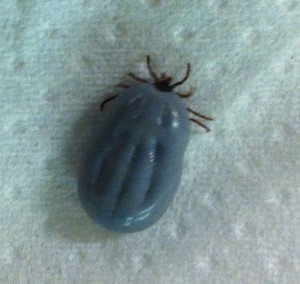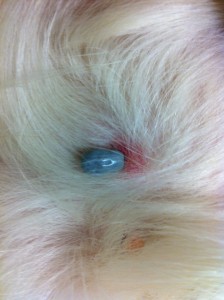Ticks
Ticks are small, grey, round-shaped insects. They attach themselves to your pet and suck their blood. They can transmit some nasty disease but thankfully these aren’t too common. Here you will find how to recognise ticks, how to remove them safely and how to prevent your pet getting them.
What are ticks?
- Ticks are athropods, which means they have 8 legs. However, they are much more insect-like than spider-like.
- Adult ticks have a small, round, grey body and short legs.
- They have a lifecycle which lasts 3 years and in each stage they need to feed from an animal to survive.
- They favour moist environments and are more likely to be found in close undergrowth such as heather or woodland. It is common to find ticks on your dog after you have been walking on the moors.
- They tend to be more common in early spring and autumn when the weather is moist and not too hot.
- They can only attach to your animal though direct contact, they cannot jump. They tend to climb to the top of plants and grasses to reach your, so are more common on the body and face.

Ticks are round, grey and have 8 legs
How do I know if my pet has ticks?
- Ticks are generally easy to spot, but can be quite small when they first attach, so you may not notice them
- They grow larger as they become engorged with blood and you will find a small, grey, pea-sized mass stuck to your pet.
- Be careful not to mistake your animals nipples for ticks! It may sound obvious, but the two can look very similar!

Ticks are generally easy to spot on your pet, but be careful not to mistake them for warts or nipples, or vice versa!
How can I get rid of ticks?
- The most important thing with ticks is NEVER to PULL THEM OUT if you see them. The head parts are extremely firmly attached and will stay buried in the skin while the body comes away. This can cause a nasty skin reaction.
- Tweezers or special tick pullers should be used to remove ticks. The most important thing to remember is to TWIST, as if you were opening a bottle. This way the head should stay with the body. Always check the head is present, the tick may well be wriggling if it is as it will still be alive. If you are in any doubt, ask your vet.
- You can coat them in vaseline, this will cause the tick to suffocate and die. The mouth parts will then relax, and the tick will fall off. However, this will take 24-48 hours
- There are various veterinary spot -on treatments that both repel and kill ticks. If a tick does bite your pet after you have treated them with an anti-tick spot-on, again they will take between 1-2 days to die.
Tick-Borne Disease
There are 3 main tick borne disease:
- LYMES DISEASE - this is the only tick-borne disease likely to be found in dogs which have not left the UK. The symptoms are variable but they include lameness, fever, lethargy, enlarged lymph nodes and occasionally a distinctive ‘bullseye’ at the sight of the bite. Diagnosis is difficult and relies on a history of ticks, the right symptoms and blood tests. Infected dogs generally respond well to antibiotics.
- EHRLICHIOSIS - In the UK this has only been seen in dogs which have travelled abroad. Symptoms include fever, lethargy, anaemia and a reduced appetite. Diagnosis is based on clinical signs, a history of ticks and blood tests. Treatment is with antibiotics but badly affected dogs may require hospitalisation.
- BABESIOSIS - Again, this is usually a disease only seen in dogs who have travelled abroad, however it has recently been diagnosed in the UK in ones who have never left the country. It can be a serious condition and symptoms include fever, lethargy, anorexia, anaemeia and even collapse. Diagnosis is based on clinical signs, blood tests and, usually, a history of travel. Treatment can be difficult and is more successful if the condition is caught early. You vet will prescribe antibiotics and supportive care.
- Tick borne diseases do occur in cats but are much rarer than in dogs.
- If you are at all concerned about your pet, then you should contact your vet immediately
Please note, this is an advice only website. If you have any specific queries about your pet, you should contact your vet.